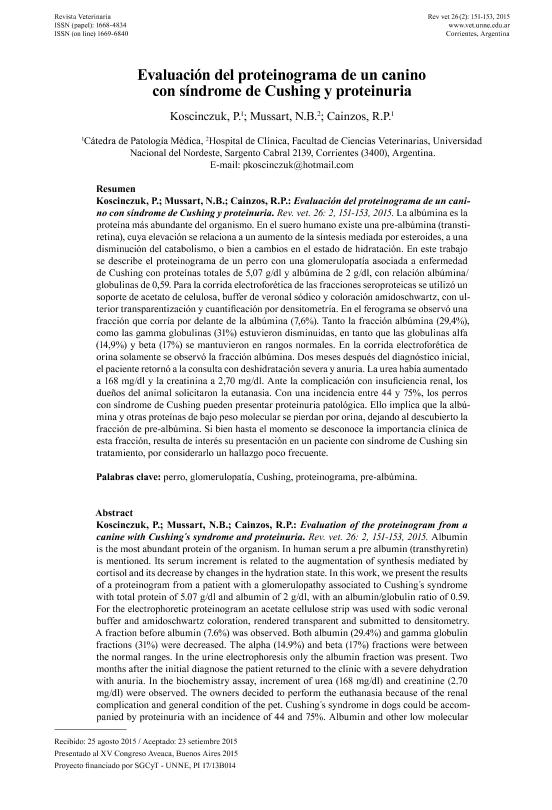Mostrar el registro sencillo del ítem
dc.contributor.author
Koscinczuk, Patricia

dc.contributor.author
Mussart, Norma Beatriz

dc.contributor.author
Cainzos, Romina Paola

dc.date.available
2018-03-08T22:00:17Z
dc.date.issued
2015-12
dc.identifier.citation
Koscinczuk, Patricia; Mussart, Norma Beatriz; Cainzos, Romina Paola; Evaluación del proteinograma de un canino con síndrome de cushing y proteinuria; Universidad Nacional del Nordeste. Facultad de Ciencias Veterinarias; Veterinaria; 26; 2; 12-2015; 151-153
dc.identifier.issn
1668-4834
dc.identifier.uri
http://hdl.handle.net/11336/38366
dc.description.abstract
La albúmina es la proteína más abundante del organismo. En el suero humano existe una pre-albúmina (transtiretina), cuya elevación se relaciona a un aumento de la síntesis mediada por esteroides, a una disminución del catabolismo, o bien a cambios en el estado de hidratación. En este trabajo se describe el proteinograma de un perro con una glomerulopatía asociada a enfermedad de Cushing con proteínas totales de 5,07 g/dl y albúmin de 2 g/dl, con relación albúmina/ globulinas de 0,59. Para la corrida electroforética de las fracciones seroproteicas se utilizó un soporte de acetato de celulosa, buffer de veronal sódico y coloración amidoschwartz, con ulterior transparentización y cuantificación por densitometría. En el ferograma se observó una fracción que corría por delante de la albúmina (7,6%). Tanto la fracción albúmina (29,4%), como las gamma globulinas (31%) estuvieron disminuidas, en tanto que las globulinas alfa (14,9%) y beta (17%) se mantuvieron en rangos normales. En la corrida electroforética de orina solamente se observó la fracción albúmina. Dos meses después del diagnóstico inicial, el paciente retornó a la consulta con deshidratación severa y anuria. La urea había aumentado a 168 mg/dl y la creatinina a 2,70 mg/dl. Ante la complicación con insuficiencia renal, los dueños del animal solicitaron la eutanasia. Con una incidencia entre 44 y 75%, los perros con síndrome de Cushing pueden presentar proteinuria patológica. Ello implica que la albúmina y otras proteínas de bajo peso molecular se pierdan por orina, dejando al descubierto la fracción de pre-albúmina. Si bien hasta el momento se desconoce la importancia clínica de esta fracción, resulta de interés su presentación en un paciente con síndrome de Cushing sin tratamiento, por considerarlo un hallazgo poco frecuente.
dc.description.abstract
Albumin is the most abundant protein of the organism. In human serum a pre albumin (transthyretin) is mentioned. Its serum increment is related to the augmentation of synthesis mediated by cortisol and its decrease by changes in the hydration state. In this work, we present the results of a proteinogram from a patient with a glomerulopathy associated to Cushing´s syndrome with total protein of 5.07 g/dl and albumin of 2 g/dl, with an albumin/globulin ratio of 0.59. For the electrophoretic proteinogram an acetate cellulose strip was used with sodic veronal buffer and amidoschwartz coloration, rendered transparent and submitted to densitometry. A fraction before albumin (7.6%) was observed. Both albumin (29.4%) and gamma globulin fractions (31%) were decreased. The alpha (14.9%) and beta (17%) fractions were between the normal ranges. In the urine electrophoresis only the albumin fraction was present. Two months after the initial diagnose the patient returned to the clinic with a severe dehydration with anuria. In the biochemistry assay, increment of urea (168 mg/dl) and creatinine (2.70 mg/dl) were observed. The owners decided to perform the euthanasia because of the renal complication and general condition of the pet. Cushing´s syndrome in dogs could be accompanied by proteinuria with an incidence of 44 and 75%. Albumin and other low molecular weight proteins can be lost with urine, thus making the pre-albumin fraction detectable in serum. The clinical meaning of this fraction is not known yet, but we consider this finding of interest for those patients with Cushing´s syndrome.
dc.format
application/pdf
dc.language.iso
spa
dc.publisher
Universidad Nacional del Nordeste. Facultad de Ciencias Veterinarias

dc.rights
info:eu-repo/semantics/openAccess
dc.rights.uri
https://creativecommons.org/licenses/by-nc-sa/2.5/ar/
dc.subject
Perro
dc.subject
Glomerulopatía
dc.subject
Cushing
dc.subject
Proteinograma
dc.subject
Pre-Albúmina
dc.subject
Dog
dc.subject
Glomerulopathy
dc.subject
Cushing
dc.subject
Proteinogram
dc.subject
Prealbumin
dc.subject.classification
Ciencias Veterinarias

dc.subject.classification
Ciencias Veterinarias

dc.subject.classification
CIENCIAS AGRÍCOLAS

dc.title
Evaluación del proteinograma de un canino con síndrome de cushing y proteinuria
dc.title
Evaluation of the proteinogram from a canine with Cushing´s syndrome and proteinuria
dc.type
info:eu-repo/semantics/article
dc.type
info:ar-repo/semantics/artículo
dc.type
info:eu-repo/semantics/publishedVersion
dc.date.updated
2018-03-01T13:51:21Z
dc.identifier.eissn
1669-6840
dc.journal.volume
26
dc.journal.number
2
dc.journal.pagination
151-153
dc.journal.pais
Argentina

dc.journal.ciudad
Corrientes
dc.description.fil
Fil: Koscinczuk, Patricia. Universidad Nacional del Nordeste. Facultad de Ciencias Veterinarias. Cátedra de Patología Médica; Argentina
dc.description.fil
Fil: Mussart, Norma Beatriz. Universidad Nacional del Nordeste. Facultad de Ciencias Veterinarias. Cátedra de Patología Médica; Argentina. Consejo Nacional de Investigaciones Científicas y Técnicas; Argentina
dc.description.fil
Fil: Cainzos, Romina Paola. Universidad Nacional del Nordeste. Facultad de Ciencias Veterinarias. Cátedra de Patología Médica; Argentina. Consejo Nacional de Investigaciones Científicas y Técnicas; Argentina
dc.journal.title
Veterinaria

dc.relation.alternativeid
info:eu-repo/semantics/altIdentifier/url/http://www.scielo.org.ar/scielo.php?script=sci_arttext&pid=S1669-68402015000200013
dc.relation.alternativeid
info:eu-repo/semantics/altIdentifier/url/http://revistas.unne.edu.ar/index.php/vet/article/view/230
Archivos asociados
